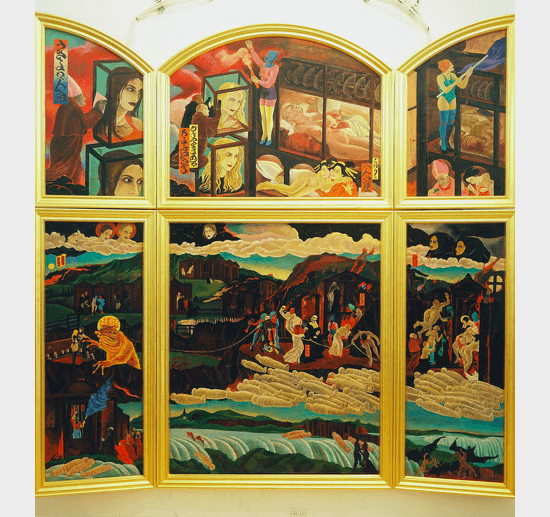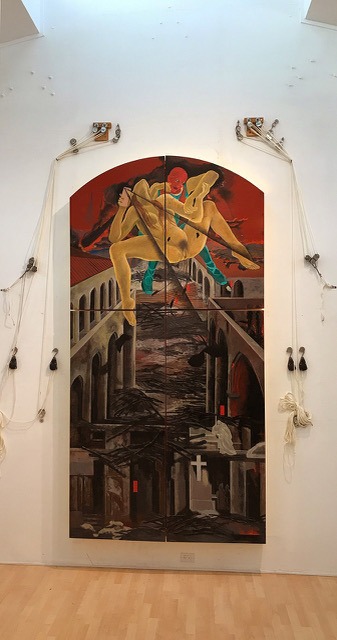

FLOATING REALITIES: The Art of Masami Teraoka. Fullerton: California State University, Fullerton / Grand Central Press. 2018, 400 pages. $75.00.
Masami Teraoka, whose artwork appeared on the covers of Kyoto Journal 10 (1983) and 24 (1993), began his artistic career copying images from the iconic Hokusai Manga in his family’s kimono shop in Onomichi, Hiroshima. Yes, he saw two suns burning in the sky on the morning of August 6, 1945. Yes, he understands how life can be lived when duality, caught in an unprecedented brilliance, has nowhere to hide.
The evolution of Teraoka’s oeuvre now can be explored in the monumental 400-page Floating Realities: The Art of Masami Teraoka, almost a catalogue raisonné. In addition to beautifully printed full color reproductions, the book includes a forward by Mike McGee (curator of the Begovich Gallery @ CSUF/Fullerton; acknowledgement by his current gallerist Catharine Clark; commentaries in Russian by Pussy Riot artists/activists Viktoria Naraxa and Masha Kechaeva, and in Japanese by Toshiki Soma and Amena El-Mekhigange; an interview with the artist by Jennie Yoon; plus resume, extensive bibliography and selected timeline. Reserve a place on your sturdiest bookshelf for this outstanding volume.
Floating Realities documents how Teraoka’s practice masterfully straddles two cultural perspectives; he is compared to the ukiyo-e masters of his “seiseis” Utagawa Kunisada, (also known as Utagawa Toyokuni III) and Katsushika Hokusai. “Utagawa Kunisada inspired me for expression of faces and figures,” he reflects, and the latter’s opus The Great Wave clearly washed over his imagination. He is also compared to English artist Gericault, Picasso and Aubrey Beardsley, the later a master of the macabre whose precise lines emphasized the grotesque, the decadent, and the erotic. (Seems that Beardsley was influenced by Japanese woodcuts!) His classic narrative structures are such as those found in kabuki and Japanese folktales.
Among Teraoka’s earliest painting teachers in Japan was Moemon Sugihara who inspired him to traverse the East-West genre bridge to become adept at a variety of artistic styles. He attained his first academic degree in aesthetics from Kobe’s Kwansei Gakuin’s Nishinomiya campus (between Osaka and Kobe) where he explored in-depth abstract painting, especially Mondrian. In the 1960s he also associated with folks involved with Gutai Bijutsu Kyōkai, (Gutai Group), Japan’s first post-war radical art movement headed by Jiro Yoshihara in Ashiya, hanging out and playing trumpet in their impromptu jazz jam sessions at parties and other “happenings.”
Attracted by the USA’s “individualism and freedom”, Teraoka traveled to Los Angeles to continue training as a contemporary artist, eventually studying abstract painting at Otis College of Art where he received his MFA in 1968. His earliest romps in laid-back American Pop Art of the 1970s offered idyllic views from and of the California coast, but the power of Japanese aesthetics would not relax the hairs on his paint brushes. While America offered laissez faire flower-power, the epic stories and gigantic, however humble characters of Japanese narratives were the stuff of novel entanglements. According to Teraoka in a recent Facebook post, “Precise depiction of the narrative helps to articulate unsettling current culture. In Japanese aesthetic you can describe this as 多様の統一 (tayo no toitsu): coherence in seemingly chaotic random setting.”
While he has been trying to figure out whether he is Japanese and/or American, he has always been looking forward and backward through his artwork. Perhaps this is why he settled in Hawaii, more in the middle of the Pacific Rim. One can easily see why noted author and curator Howard Link once called Teraoka as a “multi-faceted cultural synthesizer.”
Paintings beautifully reproduced in the book, Teraoka casts samurai, geishas and later Japanese businessmen and tourists into lampoons of the not so fantastical McDonald’s Hamburgers Invading Japan and 31 Flavors Invading Japan, two popular series that have been widely exhibited. In New Views of Mt. Fuji, he created a hilarious fantasy about Japanese businessmen purchasing and moving the La Brea Tar Pits from Los Angeles to become a theme park in Japan. His favorite characters sometimes make cameo appearances in different works, such as his alter-ego, the geisha Momotaro who has been portrayed as the Biblical Eve and the Madonna of the Pieta. His Wave series is a bow to shunga; the woman (a pearl diver) is clearly struggling as a humongous octopus overtakes her.
His frequent images of waves are more than metaphor. They reflect the artist’s commitment to place center stage the ah-ha moment of a near-drowning experience at age 13; he taught himself to swim at age 47. “That drowning experience was the keynote that next day, if I had a choice to live one more day or longer, what did I want to do?” he reflected. “The answer was painting. Become an artist.”
Between 1987 and 2011, Teraoka galvanized his social-activism concerns by executing a large series of work about the AIDS epidemic, portraying ghostly figures afflicted with Kaposi’s sarcoma and other deadly symptoms, all the while Japan’s economic bubble is bursting. Other series portray desperate New Yorkers and Londoners, Adam and Eve, environmental devastation, and the distresses of the war in Bosnia. These works form the vast majority of images in this book… but wait! There’s much more!

In the new millennium, inspired by Bill Clinton’s impeachment trial and greater confidence in his command of the nuances of language and cultural appropriation, Teraoka says, “I was ready to tackle the contemporary American narrative as homemade inspiration. So, no more ukiyo-e style work.” He changed his brushes and medium altogether. “The clergy sex abuse scandal demanded gooey oil rather than thin watercolors. In my view, content defines vocabulary!” and adopted a more Renaissance painting style with altarpiece-sized triptychs. His recent piece Hideous Ugliest Orange Toad’s Last Bolero/Viagra Falls triptych painting is featured at the “Centennial: 100 Years of Otis College Alumni” running in the Ben Maltz Gallery thru 2019. A full series of the triptychs will be on exhibit in 2020-2021 at the John Schnitzer Museum of Art at the University of Oregon.

Unleashing the full power of social protest through his extremely skillful illustrations, these commentaries on contemporary infernos and inquisitions depict wide-eyed debauched Roman Catholic church prelates lasciviously torturing women hidden deep within the protected confines of their cloisters. Now his ageless beloved geisha shares the spotlight with burqa-covered women of fundamentalist Islam in post-9-11 America. He also has embraced the public protests of Russia’s punk group Pussy Riot against Putin, the Russian Orthodox Church and a frog that has an uncanny resemblance to Trump. These images are ghastly rage-building depictions worthy of Peter Greenaway’s films,* not to mention Dante’s Decameron.
On the verso closed “doors” view of one of the triptychs, he has painted a scene with two “suns,” one being the celestial orb and the other the impact of the atomic bomb which he and his sister witnessed as children.
In 2016 he invited Pussy Riot’s Viktoria Naraxsa and Masha Kechaeva to Honolulu Museum Art School for a series of collaborative theatrical events, perhaps harkening back to his exposure to Gutai Group experimentation, The whole notion of the ‘performance’ reminded me of those exoduses of refugees in the current Middle East and Africa’s wars. Was this implying how an institution could restrict individual freedom?”
Dr. Masami, as he calls himself since receiving an honorary doctorate from Otis in 2016 for his visionary social practice, is active on Facebook and offers his friends a generous “Aloha!”— a word meaning both welcome and good-bye. I liken his good-natured, salutation to his ability to walk in the light of two suns, and to live one life in two cultures. I can only reply, “Aloha! What’s next?”
*See Lauren W. Deutsch’s review in Kyoto Journal 36 – “The Medium is the Message …. A Few of My Favorite Things About Peter Greenaway’s The Pillow Book.”
Dr. Masami Teraoka
Hideous Ugliest Orange Toad’s Last Bolero/Viagra Falls extends work that I began when I received the Lee Krasner Lifetime Achievement Award from the Pollock-Krasner Foundation, in 2017. At that time, I was at work on a series of paintings that paid tribute to the Russian activist and performance group Pussy Riot, whose members had been imprisoned by the Russian government for their protests against injustices in Vladimir Putin’s Russian government and in the Russian Orthodox Church. Upon receiving the award, I used the grant to bring members of Pussy Riot to Honolulu, Hawaii to collaborate on a new staging of William Shakespeare’s play The Tempest, that brought out themes around imprisonment, colonialism, and even magic.
The centerpiece of the new project is a series of gold-leafed framed oil painting triptychs that bring Pussy Riot back into the visual narrative as agents of social change and commentary. The first painting of the series, currently in-progress, is split between two main narratives at the top and the bottom. The top panels depict two of Pussy Riot’s members, Nadya Tolokonnikova and Masha Alekhina, enclosed in vitrines that symbolize the two years imprisonment by the Russian government. Priests and other clerical figures surround these vitrines, trying to keep them imprisoned, while other figures wearing pink balaclava masks—representing other members of Pussy Riot—blow pink smoke as a sign of protest, and as a tool for demonstration. Two figures in the foreground—a geisha and her house mother – cower from a priest who tries to kiss their toes, a gesture that is both a sign of deep respect in Christian cultures and a taboo in Japanese cultures. In the background, a nude woman lies motionless while a priest tries to become intimate with her; like Alekhina and Tolokonnikova, she is enclosed in a glass vitrine, so that the abuse enacted upon her is both enclosed and entirely visible.
The lower, larger panels depict an outrageous, highly fantastic scene where the members of Pussy Riot are depicted with the buildings on disastrous fires and saving women from their religious abusers. As they embark upon their rescue of-sorts, they throw a lasso upon a grotesque, orange toad wearing a gold coin as a halo – a reference to President Donald Trump, but also a symbol of masculinist oppression and corporate greed – while he tries to disrupt a political hearing with Trump accuser Stormy Daniels. The halo says, “Money money money, kin kin, 金金”。For the toad money is the only life criteria. In the foreground, rows of mummies, representing the men who are willingly blind to such stories of abuse, sit atop a body of water resembling Niagara Falls, only to be revived by a stimulant in the water that reawakens them and brings back their sexual desires, a symbolic move meant to suggest that the cycle of abuse—even in the “Me, Too” era—repeats itself and never stops. Above this scene, a group of celestial women—collaborators and curators from throughout my career—watch hopefully and expectantly, as if to promise hope of a new beginning and a new day.
As the series expands, I am planning to finish a complete presentation of triptychs for my solo retrospective exhibit in 2020/2021, which will be organized by the Jordan Schnitzer Museum of Art at the University of Oregon.
Masami Teraoka’s work is on exhibit at Otis College until Dec. 7, 2019: https://www.otis.edu/ben-maltz-gallery.
For more information, please visit Dr. Masami’s FB page https://www.facebook.com/

Advertise in Kyoto Journal! See our print, digital and online advertising rates.
Recipient of the Commissioner’s Award of the Japanese Cultural Affairs Agency 2013